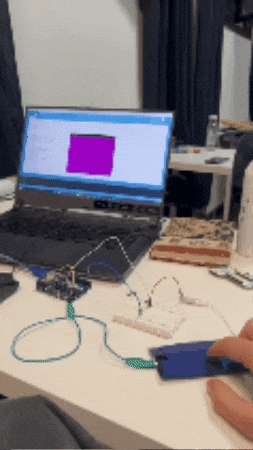*-2\\H(n)machine

It was a live coding course focused on human and machine interactions, this new relathions could be thanks live coding. Probably I will try to do some project in this field, I really enjoy and have fun. For sure our group, called Conductive nose team create an amazing vibe.
In this serial lessons we understand that our body is a tool to collect data and at the same time, due to body and mind are connected, mind is a dataset of information; as designer we could work on this field to create and shape our identity. Why? Because with human and interaction machine we'll have the power to change phenomena. Phenomena is a situtations/episode collected by us (body-mind) that it starts emotions in us.
\\ SOFT SENSORS
We built soft pressure sensors using velostat and conductive fabric, connected to Arduino, and visualized real-time data in Processing. With arduino we managed how to collect data from the sensor and with Processing we use collecting data to create a live visual. This learning by doing approach was amazing and highlighted how bodily actions can be translated into digital feedback.






\\p5.js - SOUND INTERACTION
On the second day, we focused on p5.js, an open-source platform for learning and creating live visuals and live coding. I really enjoy this website because it offers a vast library filled with examples and references. In class, we experimented with visual sketches that dynamically responded to sound inputs from the microphone.
\\p5.js - TIME based INTERACTION
In the third session, we explored serial communication between Arduino and p5.js using the Web Serial library. By mapping pressure sensor data to the size and color of a circle, we created a dynamic visual response. Additionally, implemented time-based animations, showcasing how real-time data and user interaction can visually represent bodily states.
PLAY//FUN//LEARNING
\\ SENSING and SENSATING symposium
We had an immersive and amazing workshop with Umanesimo Artificiale is a non-profit cultural organization and collective of international creative coders based in Fano, Italy. Founded by Filippo Rosati, it explores the question: "What does it mean to be human in the era of artificial intelligence?"

The collective promotes coding and computational creative thinking through digital and performing arts, aiming to foster a fruitful interaction between humans and machines. So in this workshop we developed an exhibition that explores the question and subquestion about human and machine interaction.

For our final project in the H(n)MI workshop, our group chose to explore music interaction through P5.js. We began by creating a simple theremin-inspired digital instrument, where mouse movements controlled the oscillator's frequency and volume. Our initial objective was to replace the mouse input with hand tracking, aiming to create a more intuitive and performative experience.
As our project evolved, we recognized the potential of not only rethinking the interaction method but also diversifying the sound output. To further expand our exploration, each team member developed a distinct hand/(non)hand-controlled instrument, culminating in a collaborative orchestra performance we named "Conductive Noise Orchestra."
Ziming designed a system where finger movements controlled multiple sound layers, generating complex textures.
Javi created a mixing table where two index fingers manipulated track transitions, with the Y-axis adjusting volume and the X-axis controlling playback speed.
Andrea focused on percussive sounds and effects, using mouth opening and closing to trigger drum beats.
In our git hub repository you could find all the code and if you would have fun you can play it on p5 website, we're glad to see people enjoy our project. Btw the git hub link is on the top website page.
\\ REFLECTION
I think this symposium was just amazing, I reach some goals that I would never believe to done. Is always a pleasure work in team and help each other, in this workshop we were split in different group but every body helps each other like a big family.
I don't know if I will never work in this field, but for sure is a very interesting approach to understand the interaction between human and machine; for speculative design methodologies I believe this kind of workshop are perfect.
For sure I learn a lot of things in just two days, so I'm so happy and I feel more comfortable now in this fields, at the MDEF's journey beginning I was really scared by technologies and in particular in coding. Now I feel more free because step by step I'm understanding this digital words.
Last updated